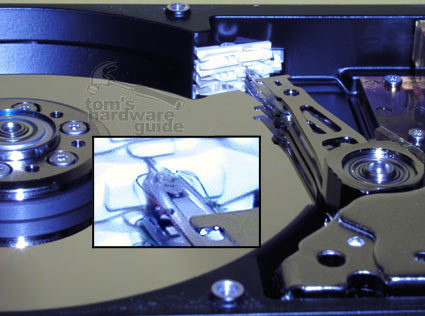A Sturdy Companion: Olixir Mobile Data Vault 3DX
Comparison: Shock Resistance Of Hard Drives
The read-write heads of a hard drive are tiny components that exhibit a high degree of sensitivity. Pictured here is an IBM hard drive, the Deskstar 75GXP, with its heads parked.
In their specifications, all drive manufacturers list the sensitivity of their products to mechanical interference. "G" indicates the earth's gravitational pull at sea level. A distinction must be made between interference while it is running (operating) and interference when it is switched off (non-operating). In the last case, the read-write heads are in a secured position (see picture), which never leads to damage when handled appropriately.
All of the newer hard drives can survive gentler bumps and jolts without any difficulty. Here we mean, for example, bumping the computer under the desk with your leg. In such cases, the read-write heads simply need to be redirected, which will "only" affect performance.
What is more critical, however, are the more serious vertical impacts of any kind, because contact of the read-write heads with the media will, in the worst possible scenario, quickly cause total failure of the drive. As a result, the following should be avoided:
- Dragging a computer across a carpeted surface in such a way that it "hobbles"
- Lifting the computer, or only one side of it, and then setting it down with a rough jolt
- Doing maintenance work on the computer while it is running (unfortunately this happens all too often)
On the other hand, interferences are hardly problematic when the computer is switched off. In this case, damage can only be caused by rough handling, such as:
- Dropping a hard drive
- Tipping over a hard drive that is standing on its side
- Roughly bumping the drive against hard objects
Such impacts are harmful not only to the device's life expectancy, but also to the ball bearings that are used most of the time. You can recognize handling errors in desktop hard drives with 5,400 or 7,200 rpm from things like the operating noise, when it becomes a louder-than-average whir. This can be prevented by using fluid dynamic bearings.
For the most part, isolated bumps will not harm a drive immediately, but recurring impacts will. This is precisely what Olixir set out to prevent with its External Data Vault, and they achieved it by insulating the installed drive as heavily as possible (see pages to follow).
Get Tom's Hardware's best news and in-depth reviews, straight to your inbox.
| Drive Model | Shock Resistance (operating) | Shock Resistance (non-operating) |
|---|---|---|
| Hitachi 7K250 | 55 G | 350 G |
| Maxtor DiamondMax Plus 9 | 60 G | 300 G |
| Seagate Barracuda 7200.9 | 63 G | 350 G |
| Western Digital WD2500JB | 65 G | 350 G |
| Olixir Data Vault 3DX | 55/60 G (Maxtor/Hitachi) | 1200 G |
Current page: Comparison: Shock Resistance Of Hard Drives
Prev Page The Outdoor Hard Drive: Data Vault 3DX From Olixir Tech Next Page Olixir Data Vault 3DX In Detail
Patrick Schmid was the editor-in-chief for Tom's Hardware from 2005 to 2006. He wrote numerous articles on a wide range of hardware topics, including storage, CPUs, and system builds.
